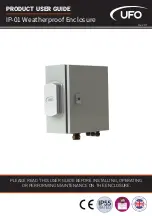
VessRAID 1000i Series Product Manual
262
The write policy automatically changes to Write Thru. When the battery comes
back online, the write policy automatically changes back to Write Back.
To enable the Adaptive Writeback Cache option, see “Making Controller Settings”
on page 96 (WebPAM PROe) or page 147 (CLU).
Also see “Replacing the Cache Battery” on page 240.
Capacity Coercion
This feature is designed for fault-tolerant logical drives (RAID 1, 1E, 5, 10, 50,
and 60). It is generally recommended to use physical drives of the same size in
your disk arrays. When this is not possible, physical drives of different sizes will
work but the system must adjust for the size differences by reducing or coercing
the capacity of the larger drives to match the smaller ones. With VessRAID, you
can choose to enable Capacity Coercion and any one of four methods.
Enable Capacity Coercion and choose the Method in the Controller Settings
menu. See page 96 (WebPAM PROe) or page 147 (CLU). The choices are:
•
GB Truncate – (Default) Reduces the useful capacity to the nearest
1,000,000,000 byte boundary.
•
10GB Truncate – Reduces the useful capacity to the nearest 10,000,000,000
byte boundary.
•
Group Rounding – Uses an algorithm to determine how much to truncate.
Results in the maximum amount of usable drive capacity.
•
Table Rounding – Applies a predefined table to determine how much to
truncate.
Capacity Coercion also affects a replacement drive used in a disk array.
Normally, when an physical drive fails, the replacement drive must be the same
capacity or larger. However, the Capacity Coercion feature permits the
installation of a replacement drive that is slightly smaller (within 1 gigabyte) than
the remaining working drive. For example, the remaining working drives can be
80.5 GB and the replacement drive can be 80.3, since all are rounded down to
80 GB. This permits the smaller drive to be used.
Without Capacity Coercion, the controller will not permit the use of a replacement
physical drive that is slightly smaller than the remaining working drive(s).
Initialization
Initialization is done to logical drives after they are created from a disk array.
Initialization sets all data bits in the logical drive to zero. The action is useful
because there may be residual data on the logical drives left behind from earlier
configurations. For this reason, Initialization is recommended for all new logical
Summary of Contents for VessRAID 1720i
Page 1: ...VessRAID 1720i 1730i 1740i 1820i 1830i 1840i Product Manual Version 1 1 ...
Page 16: ...VessRAID 1000i Series Product Manual xvi ...
Page 114: ...VessRAID 1000i Series Product Manual 98 The changes take effect immediately ...
Page 126: ...VessRAID 1000i Series Product Manual 110 Figure 8 Disk Status LED Disk Status ...
Page 154: ...VessRAID 1000i Series Product Manual 138 ...
Page 165: ...Chapter 5 Management with the CLU 149 Figure 4 Controller Status LED Controller Status ...
Page 226: ...VessRAID 1000i Series Product Manual 210 ...
Page 260: ...VessRAID 1000i Series Product Manual 244 ...
















































